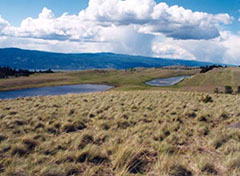Rangeland ecology
Sustainable livestock operations depend on healthy plant communities. Rangeland ecology studies relationships between plants, animals and their environment to achieve desired management objectives like maintaining or improving current plant communities, sustaining livestock production and providing wildlife habitat.
Range ecology supports land management by answering:
- How does grazing (and grazing exclusion) impact the structure and composition of a plant community, particularly over time?
- What is the impact of fire on rangeland ecosystems?
- How important are biotic crusts to rangeland health, particularly in arid plant communities?
On this page
- Format for range type summaries
- Range type summaries
- Range management guides
- Rangeland health brochures
Format for range type summaries
Range type summaries follow a consistent format. Naming of range types aligns with the Biogeoclimatic Ecosystem Classification system (BEC). Each range type represents a broad range of similar plant communities. The different categories of information contained in range type summaries are described below.
Range types
Each range type contains a description of the potential natural plant community along with some seral stages and recommended practices to maintain or improve the current plant community.
Naming of the types is based on the perceived potential of the site, and aligns well with the plant association concept used the in the biogeoclimatic ecosystem classification system (BEC). In an attempt to simplify the project, each range type represents a very broad range of similar plant communities. These range types follow the BEC as a framework for classification as much as possible and correlation to the BEC has been included in each account. Some types, though, are not described in the BEC, and for others, only seral stages have been described.
The Clementsian succession model has been adopted for most situations. Potential Natural Community (PNC), late-seral, mid-seral, and early-seral stages have been described for most range types. Recover from early seral through to PNC is expected if grazing and other disturbances are removed. There are a few exceptions where the plant community has been driven beyond a returnable threshold. These are described as “Altered States” in the accounts.
Seral stages are defined by their similarity to the PNC. Late-seral is 50 to 75% similar; Mid-seral is 25 to 50% similar; and early-seral is less than 25% similar.
Late-seral is targeted as the desired plant community for range management. PNC cannot be maintained with a commercial level of grazing and mid- and early-seral stages are more susceptible to invasive plants, erosion and soil compaction, and are often less productive. We assume that the Forest and Range Practices Act (FRPA )objectives will be met if the majority of land is managed for late-seral.
Plant community and cover estimates
Reference area exclosures and relic sites provide information on what plant community composition could be at PNC.
The other seral stages are described based on interpretations of data from areas surrounding exclosures and observations of other communities. Variability of plants included and canopy cover within the PNC and late-seral is low but increases at lower seral stages. Wide ranges in species cover reflect uncertainty in describing the early-seral stages. History of disturbance, chance events or conditions that we do not understand drive the early-seral stages to many different expressions.
Forage production
Production values give an estimate of the herbage that is likely to be eaten by livestock and does not include shrubs or trees. Estimates are based on various clipping projects and extrapolations over the entire range type. Forage production is highly variable, and dependent on annual precipitation particularly the April to June period, but also the preceding fall and winter and on soil and slope position. Use the information cautiously. In general, production from later seral stages will be less variable while production from earlier seral stages (especially those dominated by annual plants) will show extreme swings.
Forage production estimates are for mid-summer peak production. When pastures are grazed early in the year growth will be less and adjustments to the carrying capacity have to be made. We do not have an estimate of the reduction for each type, but at time of range readiness, production may be as little as 30% of the peak.
Carrying capacity
Carrying capacity is determined by reducing the forage production by a safe use level and is expressed as Animal Unit Months per hectare (AUM/ha) based on 450 kg/AUM. It does not include reductions for limiting factors. The actual stocking rate used on an area has to take into account limiting factors and adjustments to the carrying capacity if the recommended grazing regime is not used. For example a lower grassland range type carrying capacity assumes use one in two years, at not more than 35% use. If use is greater, or rest shorter, the carrying capacity will be less; if use is less, or rest is longer, then the carrying capacity will be more.
Range type summaries
Below are PDF documents describing the different types of rangeland in B.C.
Range type summaries - all B.C.
- Alkali saltgrass (PDF, 384KB)
- Awned sedge (PDF, 471KB)
- Barclay willow (PDF, 409KB)
- Beaked sedge (PDF, 167KB)
- Cattail (PDF, 366KB)
- Crested wheat grass seeded lower grassland (PDF, 1.6MB)
- Douglas fir bunchgrass (PDF, 692KB)
- Douglas fir pinegrass (PDF, 1.1MB)
- Great bulrush (PDF, 256KB)
- Grey leaved willow - glow moss (PDF, 338KB)
- Kootenay middle grassland (PDF, 357KB)
- Lodgepole pine pinegrass (PDF, 569KB)
- Nevada bluegrass (PDF, 513KB)
- Nuttall's salt grass (PDF, 334KB)
- Okanagan lower grassland (PDF, 462KB)
- Peace aspen forest (PDF, 303KB)
- Peace grassland (PDF, 247KB)
- Peace shrubland (PDF, 560KB)
- Scrub birch (PDF, 498KB)
- Southern Interior yellow pine forest (PDF, 1.2MB)
- Spike rush (PDF, 382KB)
- Sub-alpine fescue grassland (PDF, 355KB)
- Sub-alpine tall forb (PDF, 931KB)
- Thompson Nicola lower grassland (PDF, 600KB)
- Thompson Nicola middle grassland (PDF, 326KB)
- Thompson Nicola upper grassland (PDF, 1MB)
- Tufted hairgrass (PDF, 488KB)
Range type summaries - Okanagan
- Alkali saltgrass (PDF, 483Kb)
- Awned sedge (PDF, 471KB)
- Barclay willow (PDF, 409KB)
- Beaked sedge (PDF, 146KB)
- Cattail (PDF, 336KB)
- Crested wheat grass seeded lower grassland (PDF, 1.5MB)
- Douglas fir bunchgrass (PDF, 692KB)
- Douglas fir pinegrass (PDF, 1.1MB)
- Great bulrush (PDF, 256KB)
- Grey leaved willow - glow moss (PDF, 338KB)
- Lodgepole pine pinegrass (PDF 569KB)
- Nevada bluegrass (PDF, 315KB)
- Nuttall's salt grass (PDF, 445KB)
- Okanagan lower grassland (PDF, 642KB)
- Southern Interior yellow pine forest (PDF, 1.2MB)
- Sub-alpine tall forb (PDF, 931KB)
Range type summaries - Thompson Nicola
- Alkali saltgrass (PDF, 483KB)
- Awned sedge (PDF, 471KB)
- Barclay willow (PDF, 409KB)
- Beaked sedge (PDF 416KB)
- Cattail (PDF, 336KB)
- Crested wheat grass seeded lower grassland (PDF, 1.5MB)
- Douglas fir bunchgrass (PDF, 692KB)
- Douglas fir pinegrass (PDF, 1.1MB)
- Great bulrush (PDF, 256KB)
- Grey leaved willow - glow moss (PDF, 338KB)
- Lodgepole pine pinegrass (PDF, 569KB)
- Nevada bluegrass (PDF, 315KB)
- Nuttall's salt grass (PDF, 338KB)
- Spike rush (PDF, 382KB)
- Sub-alpine tall forb (PDF, 931KB)
- Southern Interior yellow pine forest (PDF, 1.2MB)
- Thompson Nicola lower grassland (PDF, 600KB)
- Thompson Nicola middle grassland (PDF, 326KB)
- Thompson Nicola upper grassland (PDF, 1MB)
Range type summaries - Cariboo
- Alkali saltgrass (PDF, 483KB)
- Awned sedge (PDF, 471KB)
- Barclay willow (PDF, 409KB)
- Beaked sedge (PDF, 416KB)
- Cattail (PDF, 336KB)
- Crested wheat grass seeded lower grassland (PDF, 1.5MB)
- Douglas fir bunchgrass (PDF, 692KB)
- Douglas fir pinegrass (PDF, 1.1MB)
- Great bulrush (PDF, 256KB)
- Grey leaved willow - glow moss (PDF, 338KB)
- Lodgepole pine pinegrass (PDF, 539KB)
- Nevada bluegrass (PDF, 315KB)
- Nuttall's salt grass (PDF, 443KB)
- Scrub birch (PDF, 498KB)
- Southern Interior yellow pine forest (PDF, 1.2MB)
- Spike rush (PDF, 382KB)
- Sub-alpine tall forb (PDF, 931KB)
- Tufted hairgrass (PDF, 488KB)
Range type summaries - Kootenay
- Alkali saltgrass (PDF, 483KB)
- Awned sedge (PDF, 471KB)
- Barclay willow (PDF, 409KB)
- Beaked sedge (PDF, 416KB)
- Cattail (PDF, 336KB)
- Crested wheat grass seeded lower grassland (PDF, 1.5MB)
- Douglas fir bunchgrass (PDF, 692KB)
- Douglas fir pinegrass (PDF, 1.1MB)
- Great bulrush (PDF, 256KB)
- Grey leaved willow - glow moss (PDF, 338KB)
- Kootenay middle grassland (PDF, 367KB)
- Lodgepole pine pinegrass (PDF, 569KB)
- Nevada bluegrass (PDF, 315KB)
- Nuttall's salt grass (PDF, 443KB)
- Spike rush (PDF, 382KB)
- Sub-alpine tall forb (PDF, 931KB)
Range type summaries - Peace
- Alkali saltgrass (PDF, 483KB)
- Awned sedge (PDF, 471KB)
- Barclay willow (PDF, 409KB)
- Beaked sedge (PDF, 416KB)
- Cattail (PDF, 336KB)
- Great bulrush (PDF, 256KB)
- Grey leaved willow - glow moss (PDF, 338KB)
- Lodgepole pine pinegrass (PDF, 569KB)
- Peace aspen forest (PDF, 303KB)
- Peace grassland (PDF, 247KB)
- Peace shrubland (PDF, 560KB)
- Scrub birch (PDF, 498KB)
- Spike rush (PDF, 382KB)
- Sub-alpine fescue grassland (PDF, 255KB)
- Sub-alpine tall forb (PDF, 931KB)
Range management guides
Farmers and ranchers support these ecological processes through due diligence, and best practices and principles of range management.
- Rangeland Seeding Manual (PDF, 23MB)
- The Four Principles of Range Management (PDF, 818KB)
- Forage Supply Analysis: the Range Vegetation Inventory (PDF. 1.9MB)
- A Different Form of R & R (PDF, 1.6MB)
- Livestock Grazing Best Management Practices on Crown Range in Community Watersheds (PDF, 3.2MB)
- Water quality and livestock grazing on Crown rangeland in British Columbia (PDF, 371KB)
- Determining Range Readiness and Growing Degree-Days (PDF, 3.3MB)
- Range Resources Assessment Procedures (PDF, 1.4MB)
- Using Range Readiness Criteria (PDF, 765KB)
- Cattelguard Specification February, 2015(PDF, 522KB)
Rangeland health brochures
- Rangeland Health Field Guide (PDF, 1.3MB)
- #1: Assessing Upland and Riparian Areas (PDF, 835KB)
- #2: Arriving at Remedial Measures (PDF, 494KB)
- #3: Understanding Ecosystem Processes (PDF, 473KB)
- #4: Considering Tools for Remediation (PDF, 554KB)
- #5: Using Range Readiness Criteria (PDF, 765KB)
- #6: Applying Best Stubble Height on Rangelands (PDF, 1.3MB)
- #7: Determining Available Forage (PDF, 512KB) see also: Forage Supply Analysis: the Range Vegetation Inventory (PDF. 1.9MB) and webpage Forage Supply Analysis
- #8: Factors Influencing Livestock Behaviour and Performance (PDF, 1.3MB)
- #10: A Methodology for Monitoring Crown Range (PDF, 1.3MB)

The Society for Range Management has compiled a range management glossary:
Monitoring and evaluation
Pasture and range health
Contact information
Contact your Natural Resource District and Range Officer if you have questions about rangeland use in a specific Natural Resource District. Please direct general questions to:
Forests.RangeBranch@gov.bc.ca
Range.GrazingLeases@gov.bc.ca
Invasive.Plants@gov.bc.ca
Range.Practices@gov.bc.ca
Range.GrazingPolicy@gov.bc.ca

